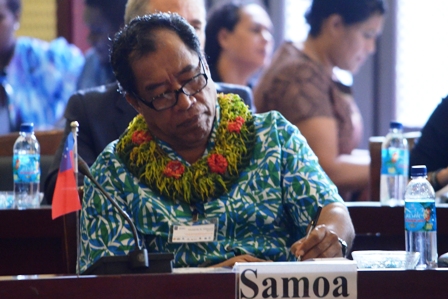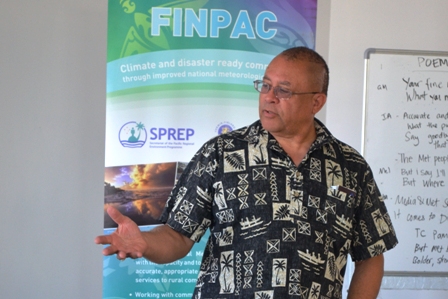
Climate Change Resilience
Ms. Faumuina Felolini Tafuna’I writing for the Samoa Observer
23 July, 2015, Nuku’alofa, Tonga, PMC-3 - Samoa and American Samoa’s weather and climate services are leading the way in increased bilateral co-operation between the nations.
Samoa Meteorology Division ACEO Mulipola Austealia Titimaea said the Meteorological offices agreed to work together so that their communities would get more accurate information.
“For instance when cyclones form and approach from the west, Samoa takes the lead and when a tropical system forms and approaches from the east, American Samoa takes the lead,” said Mulipola.

Muliploa Ausetalia Titimaea, Director of Samoa Meteorological Services
Knowing who took the lead was especially important for the eastern islands of American Samoa, who received broadcasts from both weather services, which were not always giving the same message.
Mulipola said the two Samoa meteorology offices also had to agree on the terminology, both in English and in Samoan, used in warnings.
Prior to the Two Samoas Tropical Cyclone Coordination meetings resuming in 2006, the Met Offices in Pago Pago and Apia began co-operating under the Two Samoas Framework back in 1998.
Both Samoas are represented this week at the Third Pacific Meteorology Council in Tonga.
Mr. Ed Young, the Deputy Director for the National Weather Service (NWS) Pacific Region Headquarters, a branch of the National Oceanic Atmospheric Administration (NOAA) located in Honolulu, represented the programs provided by the NWS Office in American Samoa to the government and people of American Samoa.

Mr. Ed Young addresses the Pacific journalists
Young said two Samoas attempted to work through some differences in how they operated around tropical cyclones and tsunamis.
He said the two countries had different thresholds for tsunami alerts based on their experience.
“You are dealing with different political jurisdictions and each has sovereign responsibilities to look after their people as best as they can. It’s also to do with the comfort zone of each country in terms of different earthquake magnitude threshold, and to lessen the occurrences of false alarms. ”
American Samoa’s Weather Service Office operates under guidelines used for US states and territories. The guidelines are different to those used by Samoa. The US averages wind speeds over a one-minute interval, while Samoa follows international meteorological standard of averaging wind speeds over 10 minutes.
Young said it was critical the Met Offices in both Samoas conduct regular education and outreach to government agencies, the media, and the public, to remind their users of the products issued by their respective Met Offices.
The two Met Offices also had a dedicated' hotline' telephone system that was set up in 2001, as part of a second E-1 microwave link between their respective telecommunications companies dedicated for health, education, aviation, and meteorology. But this equipment is now outdated and has not worked for the past three years.
Both countries are looking at ways to replace the ' hotline' to IP phone technology prior to the start of the next tropical cyclone season. - #PacMC2015
Ms. Faumuina Felolini Tafuna’i is a freelance journalist writing for the Samoa Observer - www.samoaobserver.ws
This article was developed by a Pacific Media Team of Reporters currently providing coverage on the Third Pacific Meteorological Council in Tonga. This activity coordinated by SPREP is supported by a partnership including the Government of Tonga, SPREP, Finland Ministry of Foreign Affairs, Finnish Meteorological Institute (FMI), World Meteorological Organization (WMO) and the Pacific Media Assistance Scheme (PACMAS).
This article was developed by a Pacific Media Team of Reporters currently providing coverage on the Third Pacific Meteorological Council in Tonga. This activity coordinated by SPREP is supported by a partnership including the Government of Tonga, SPREP, Finland Ministry of Foreign Affairs, Finnish Meteorological Institute (FMI), World Meteorological Organization (WMO) and the Pacific Media Assistance Scheme (PACMAS).